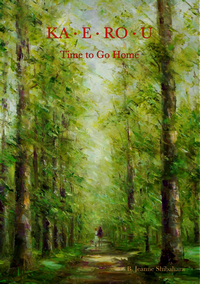 KA-E-RO-U Time to Go Home
KA-E-RO-U Time to Go Home
by B. Jeanne Shibahara
Kindle Edition, 259 pg.
2018
Read: April 5 – 8, 2019

Every so often I get a book that I struggle writing about. I know what I want to say about it, but I’m worried that my point will get lost. So, stymied, the file sits blank on my screen for a couple of days while I hem and haw. I’ve been doing that for most of the week about this book (and afraid it was going to happen last week). Hear me out.
There are so many things that I’d typically complain about in a book — casual disregard for grammar, sentence structure, mechanics; characters that behave like characters in a book, not people; a plot that makes sense to no one (well, part of it, anyway). Really, this is not a good novel.
But . . . dang it, there’s something about this book that I liked. It’s like a long, meandering Sunday drive — or walk in the woods — you take a windy road/path to nowhere in particular — occasionally stopping at a scenic overlook or wandering from the route for a bit before resuming. You don’t get anywhere fast, you may hit a bumpy/rocky patch, but overall you count it as a pleasant afternoon.
So Meryl’s a Vietnam widow (it’s pretty unclear when this happens — other than her son is an adult now) comes into possession of a flag that belonged to a fallen Japanese soldier from the War in the Pacific. She’s pushed to go to Japan (where her son teaches English) to return the flag to the soldier’s family. She ends up going on the trip and finds the freedom and ability to move on from her husband’s death.
The love story is ludicrous. Actually, there are a couple of them (three) — and they’re all ridiculous, and old Disney cartoons do a better job depicting love. They’re not the actual heart of the book — but man, they get all the attention. The heart of the novel is this simple story of the return of this flag to what’s left of the family of this soldier.
When the novel focuses on that story? It’s a real winner. I can believe those people, I can believe those reactions. I can believe it– and I want to read it (not just put up with it). In addition to this, the looks at Japanese culture are great — on the whole, this novel doesn’t focus on the parts of Japanese culture usually featured in books/films.
We spend way too much time with characters — pages and pages — just for them to appear for a paragraph or three in the story. As interesting as these journeys into backstory may be, by the time we get back to the story for them to disappear just drives me crazy.
To put it in the kindest way I can: this is a very idiosyncratic with a charm that is its best feature. It’s sweet. The historical and cultural insights are great (and almost worth the effort alone). If you give this book a chance — and a lot of leeway — it’ll win you over.
Disclaimer: I received a copy of this novel from the author in exchange for my honest opinion, I think it’s clear that my opinion wasn’t that swayed by it.
—–
![]()



